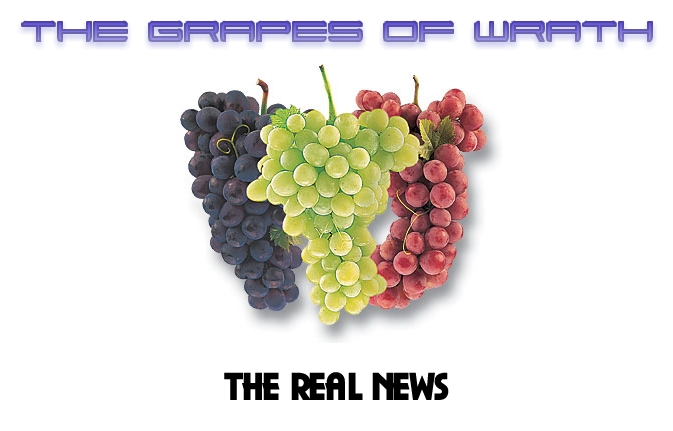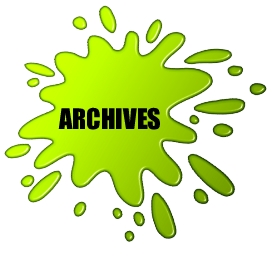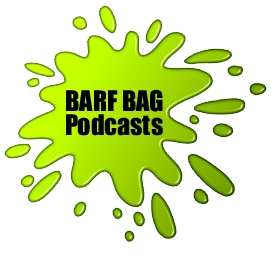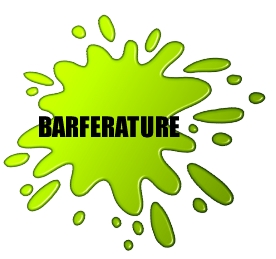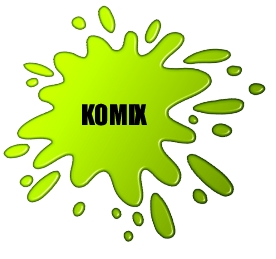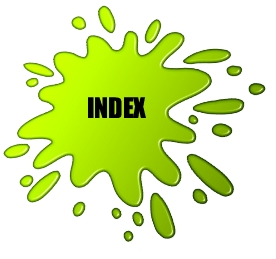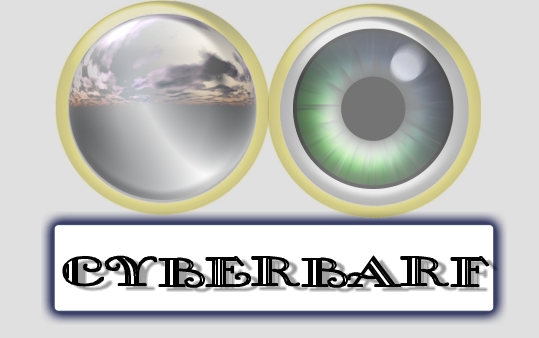|
cyberbarf10.10 cyberculture, commentary, cartoons, essays EXAMINE THE NET WAY OF LIFE MAY, 2011
IN THIS ISSUE:
|
|
cyberbarf OLD COMPUTER SEARCH CYBERSAFARI™ When one thinks RETRO, one thinks of old things, old Classic things. And what is more classic nowadays than computers. Computers used to be gigantic machines, turned into personal towers, into laptops and now into hand held devices; from rare, to utilitarian, to fad. Since this issue is about jogging the memory banks, we decided to look at the old machines that we still have in the old homestead which runs the gambit of cutting edge technology (it has to be so, because that is one of the external hard drive brands). MACINTOSH SE w/45MB Cutting Edge drive Key Data: Finder 6.0.4 (1983-1989); Memory 2,048k: Finder 1,879k, System 16k Apple Menu: Suitcase which lists underneath it: Alarm Clock, Calculator, Chooser, Control Panel, Find File, Key Caps, Scrapbook. The SE was the first Mac to actually force its way into the office environment and was a hit with the nouveau home computing crowd. On our hard drive (which booted fine after YEARS of inactivity) were folders (in black and white screen) called System, Utilities, Rotisserie (fantasy baseball league), Excel Tour, Excel, Hypercard Stacks, MicroLeague (baseball game), Golf, Ready Set Go 4.5 (page layout), Word 4, SuperCards, Microsoft QUICKBASIC, Paint 2.0, SimCity 1.2, Earl Weaver BB, and Casino. The early Apple Computers got the unfair reputation that they were only hobbyist game machines, but if you went to a computer store in the 1990s, Windows/Microsoft games clearly outnumbered Mac games by 1,000-1. Very few game manufacturers released two different versions of the same game. This was the front lines of the Microsoft vs. Mac which-is-better war for fan loyalty. But this machine contained the basic work programs of Word, Excel and page layout program. It is also interesting to note that home computing was still so new, and the frontier so wide open, that people bought and used their own BASIC programming tools, or in Apple's view, HyperCard program to create simple data base applications under the index card shuffle. POWER COMPUTING TOWER Key Data: Finder Mac OS 8.5(1983-1998); Memory 160MB, Virtual Memory 161 MB on Hard Drive: System 17.4MB Apple Menu: AOL4, Apple System Profiler, Apple CD Audio Player, Automated Tasks, Calculator, Chooser, Control Panels, Favorites, Graphing Calculator, Internet Access, Jigsaw Puzzle, Key Caps, Network Browser, Note Pad, Recent Applications, Recent Documents, Remote Access Status, Scrapbook, Sherlock, Simple Sound, Stickies The Power Tower in the late 1990s was the first Apple clone. We bought the tower because it was the first Apple clone: it was cheaper than a regular Apple, but was supposed to have all the same operating features. Apple soon shut off clone makers so the Tower is a unique orphan in the computer museum. Since this is a home purchase, it was not loaded with much business software. The hard drive has the following folders/applications: Chessmaster 4000, Civilization II, Cybersound Studio 3.0, Games, Jack Nicklaus Golf, Internet, Madden NFL 2000, MacLinks Plus 9.0, Netscape 4.51, Norton AntiVirus, Open Transport/PPP, Painter 3.0, PCC Bundled software of Acrobat 3, Director 5, Nisus Writer, Now Software, Railroad Tycoon, Ray Dream Designer 4.1 and SimCity 3000. It is interesting to note that in a mere ten years, computer memory jumped from 2 KB to 160 MB and computer drives from 45 MB to 160 MB in order to run the basic operating system from 16k to 17.4MB! There is also the increase in basic operating system features, including the expansion into audio, networking and internet access programs. iMAC (Snow White Version) Key Data: OS 10.2.6 (1983-2003); Memory 384 MB: 28 GB hard drive; 500 Mhz PowerPC G3 Apple Menu: in OS9 (replaced by Dock in OS 10) Suitcase which lists underneath it: Airport, AOL5, Apple System Profiler, Calculator, Chooser, Control Panels, Favorites, Key Caps, Network Browser, Quicken.com, Recent Applications, Recent Documents, Remote Access Status, Scrapbook, Sherlock 2, Speakable Items, Stickies. The first iMacs broke the design mode for personal computers. The tapered wedge desktop design was so different than the bulky towers and TV set monitors in the PC market. This machine is still used a lot. It contains dual operating systems because there are programs that were not compatible with the upgrade to System OS X. Acrobat 5, AOL 10.3, Appleworks 6.2, Chess 1.2, DVD player 3.2, iMovie 2.1.2, Explorer 5.2.2, iTunes 3.0.1, ScanWise X, LogoCreator 3, Pagemaker 6.5, Photoshop 5.0, Britannica (the encyclopedia on a single disk), eWorld, Dreamweaver 3, Links LS 2000, and Tropico. This machine is still used for basic word processing, email, artwork and web page design and uploading to web sites. iMAC (flatscreen) Key Data: Finder OS 10.5.8 (2009); Memory 2.0 GB: 1.8Ghz PowerPC G5 Apple Menu: (Replaced by Dock, except for Recent Items) Another design innovation by Apple, which put the entire computer into a flatscreen monitor case. The sleek and uncluttered look was soon copied by its competitors. This machine has been used for graphics, digital photography, music and digital camcorder (iMovie and iDVD) home movie production. Applications on the hard drive include Photoshop 7, Appleworks 6.2, Art Rage 2, Coral Painter, Groboto, Garageband, iMovie, idvd, Explorer 5.2.3, Safari 5.0, Microsoft Office 11, Nanosaur 2, Poser 6, Quicken 2004, Shade 7 LE, LogoCreator 3, Vue 5/6. The powerful processor is needed to download digital images and to burn DVDs for family and friends. The large screen is nice for graphic programs which tend to have numerous tool windows open at all times which could crowd a small screen landscape. So what do all these older machines have in common? It is an interesting question. They all have functioning word processing programs which was fundamental for business applications. They all had the opportunity to do such work, but also had the aspect of entertaining the user with interactive games. Over time, the processing power and storage space increases allowed more features to come into play, including downloading, manipulation and creation of personal movies, music and DVDs. It is the creative power behind the machines which gives the user the opportunity to explore their own creative boundaries.
cyberbarf BASEBALL ESSAY It was the National Pasttime. It was played by soldiers between Civil War battles. It became a professional sport in the late 1880s. The basic rules and dimensions of the diamond have stayed the same for more than a century. It was a simple game that little kids could grasp at an early age. Ball, bat, glove, field. Play ball. It was a game that was perfect for literary sportswriters in the golden age of newspapers. It was a game perfect for the radio broadcaster who could perk up the imagination of the listener through his elegant prose. It was a game the nation could relate to because both urban and rural kids played it. They knew how it felt to grip the bat. They knew what it took to throw a good pitch. They knew how it felt when the bat connected with the ball; the sound, the sting. They knew of the rush of the fielder who in anticipation of a hit in his direction, like a catch perched ready to leap, and the quick lunge and sound of a hard ball sticking in soft leather. They knew the feeling of the fresh air, sand and grass funneling through one's lungs when trying to stretch a single into a double. They all knew the joy of kicking up dirt when sliding into a base. One of the great treats as a child was being able to go to a ball park. It was not an everyday event. If you were lucky enough, you would go to one of those old baseball cathedrals, Wrigley Field or Fenway Park. Places where the legends of the game once played ball. These places contained the ghosts of history around every turn, from the manual scoreboards, the simple score cards, the barking hot dog salesman in the aisle, to the organ music between innings. It was the closest thing to time travel one could have in their youth. The tech at the game was pure: a pencil and a scorecard. There was a basic format of scoring a game, but everyone had their own personal style and markings. Everyone had their own viewpoint on reading box scores in the daily paper. You could almost piece together the game. Some kids used to cut out the next day's game story and box score and clip it to their own scorecard as the ultimate souvenir. You would sit in the stands. The sky was clear blue. The field deep green. The action and sounds were familiar, just played faster and with more intensity. The pitches hitting the catcher's mitt popped like a gunshot. The speed of an outfielder running like a deer to catch a long fly ball in the gap. The awe of the fierce crack of the bat and the long arc of a home run. One would take those memories as their mental base when listening to future ball games on the radio. Baseball has been called a thinking man's sport. It is because of the vast amount of mathematical statistics each game creates: batting averages, wins, losses, earned runs, errors, runs batted in and home runs. The times have not changed the basic gold standards of player performance: 30 home runs, 100 RBIs, .300 batting average; 20 wins, 3.00 ERA. Baseball is one of those sports where fans constantly debate the great players with current ones since the statistical calculations are the same. The debates between players was the cause and effect of many school yard dust ups. Kids would then mimic their favorite players. The high kick of a pitcher like Juan Marischel. The waving batting stance of a Willie Stairwell. The low crouch of a Pete Rose. The flying spikes of a base stealer like Ty Cobb. The long jumping throws across the field like a Brooks Robinson. The circus catches of a Willie Mays. Baseball is a timeless game. It needs three hours of time to watch. It takes three hours of time to play. Today, children don't have that much unorganized free time to be kids playing pick up games down by the park, or watching a complete game on television. It costs too much money for a family of four to see a major league game. Most of the kids today are experiencing Baseball not in person, but through baseball simulation games. It is not the same experience.
cyberbarf OLD STORES ESSAY The history of computer stores is footnote in the Internet savvy shopping world. Computers were first the exclusive bastions of the Defense Department, megalithic corporations and university research centers. The average person had no hands on experience with a computing device except for a simple handheld calculator or the clicking noises of the telephone switch connections on a landline. Electronics was merely a geeky hobby for high schoolers hanging out at the Radio Shacks of the era. The concept of homebrew computers meant that people built their own devices, many to do remedial tasks or functions. At the same time, researchers were developing what many take for granted today: basic code, compilers, machine code interface, memory, motherboards, input devices, displays, and network interfaces. If one did not have the time or personal knowledge to make your own computer, then you would have to find someone who was selling them. Some ma and pop television stores would sell other electronics like stereos. A few would stock some of the first crude personal computers, marketed by its makers as game consoles. Once mass production made it more affordable, businesses started to adapt to using computer and printers instead of typewriters. Office supply stores started selling simple business packages and dot matrix printers. Even in those days, the buyer had to learn some basic understanding of C/PM or M/PM operating languages and the host of key codes in order for the computer to print a basic piece of correspondence. The systems were expensive and buggy but they were new and on the cutting edge. Then the rebels like Apple Computer decided that everyone should have a persona computer. It was like a right to have technology. So everyone got into the personal PC marketplace, including big business players like IBM and Compaq. The race was on for cheaper machines with higher or more dynamic programs. At this crossroads, the ma and pop computer shops faded away (some turned into the next gadget wave: the video rental store). There were still an army of homebrew technophiles competing for space with the newbies who wanted a plug-and-play computer utility. This spawned the golden age of computer stores. You could walk into a supermega market grocery sized technology oasis like Electek. It had row upon row of everything anyone would ever need to build or repair any machine. You could walk down 60 foot aisles of just motherboards; then another aisle just with hard drives; another with just cables. One could literally take a shopping cart and go down the aisles and assemble your own computer with the latest manufactured parts. But that was not all. There were walls stacked to the ceiling with computer monitors in their boxes. There were end caps displaying the latest computers from each manufacturer. There were dozens of aisles of computer software boxes for each type of machine. Then there were aisles of accessories. One could get lost the maze of computer items. And these computer superstores also served another purpose. Most had repair services when one needed to upgrade RAM or hard drive space in order to run the latest version of a word processing program. Even some experienced techs did not like the idea of installing early memory upgrades if they had to be soldered to the motherboard. Warranties have always been fickle and easily voided. The market took down many of the early manufacturers and suppliers. Cheaper parts and assembly overseas killed undercapitalized small technology firms. The age of the computer superstore would soon fade away when the Internet became the store front for the big players to sell directly to their customers. Today, the current computer stores are niche aisles in a Best Buy or an office supply chain or a nouveau geek arcade experience at the Apple Store. These are limited specialty stores catering to unique clientele. cyberbarf OLD PAGES COMMENTARY One must be surprised to learn that this web page was created in a very old school way. We still use the 1999 version of Dreamweaver (3.0) to create the page layouts for cyberbarf and its sister sites. It is because the materials, archives and such is contained on an old 500 MgH, PowerPC G3 Snow White iMac with 384 MB of memory. Oh, there is a DW upgrade box around here somewhere. Except it did not work. A call to the tech center said that the current DW was “too old” for the upgrade. If you wanted to upgrade the old software to run the new upgrade, you would have to buy an out-of-date program, which on the Internet sales sites cost more than the current full version of DW. So in a fit of disgust, the publisher decided not to change anything. So we soldier on, in a nostalgic tar pit of desk top publishing. There is a good side to the simplicity of the old web page programs. Designers today go overboard with graphics, links, moving advertisements, and video links that bog down page loads to molasses speeds. An occasional podcast to break up the content storytelling is a fine feature. Unless it is a bikini clad host, a video podcast bandwidth hog still seems excessive. Besides, reading and listening are “fundamental.” (Note: they still teach that in school, right?) |
|
cyberbarf EXAMINE THE NET WAY OF LIFE |
If at first you don't succeed, try, try again. Then quit. No use being a damn fool about it. W.C. Fields |
|
cyberbarf
THE STEAM PUNK SPECIAL EDITION featured new Music from Chicago Ski & the (audio) Real News: (mp3/4:14 length) NOW ENTERING OUR 10TH YEAR EXAMINING THE NET WAY OF LIFE cyberbarf™ distributed by pindermedia.com, inc. |
|
THE PINDERMEDIA STORE IS FULL OF FUN TEE-SHIRTS AND SELECTIONS. FUN . . . . VALUE . . .. FUN . . . . VALUE!
SUPPORT cyberbarf VISIT THE CYBERBARF STORE! |
cyberbarf
THE WHETHER REPORT
cyberbarf
STATUS
Question: Whether you would take your old Macintosh Plus and turn it into an aquarium? * Educated Guess
* Possible
* Probable
* Beyond a Reasonable Doubt
* Doubtful
* Vapor Dream
Question: Whether a national sales tax on Internet purchases will spawn the return of the local, brick and mortar, computer super store? * Educated Guess
* Possible
* Probable
* Beyond a Reasonable Doubt
* Doubtful
* Vapor Dream
Question: Whether jailbreaking smart phones and computer game consoles will lead to the next homebrew type computer development cycle? * Educated Guess
* Possible
* Probable
* Beyond a Reasonable Doubt
* Doubtful
* Vapor Dream
REWIND
LOST
FIND THE
THE KEY
HIDDEN
CHARACTER
ON
LOSTHEORY
cyberbarf
Distribution ©2001-2011 pindermedia.com, inc.
All Ski graphics, designs, cartoons and images copyrighted.
All Rights Reserved Worldwide.



